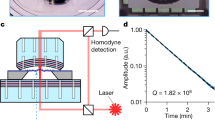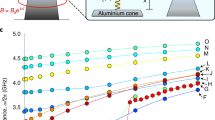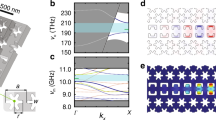Abstract
A major goal in optomechanics is to observe and control quantum behaviour in a system consisting of a mechanical resonator coupled to an optical cavity. Work towards this goal has focused on increasing the strength of the coupling between the mechanical and optical degrees of freedom. However, the form of this coupling is crucial in determining which phenomena can be observed in such a system. Here we demonstrate that avoided crossings in the spectrum of an optical cavity containing a flexible dielectric membrane enable us to realize several different forms of the optomechanical coupling. These include cavity detunings that are (to lowest order) linear, quadratic or quartic in the membrane’s displacement, and a cavity finesse that is linear in (or independent of) the membrane’s displacement. All these couplings are realized in a single device with extremely low optical loss and can be tuned over a wide range in situ. In particular, we find that the quadratic coupling can be increased three orders of magnitude beyond previous devices. As a result of these advances, the device presented here should be capable of demonstrating the quantization of the membrane’s mechanical energy.
This is a preview of subscription content, access via your institution
Access options
Subscribe to this journal
Receive 12 print issues and online access
$209.00 per year
only $17.42 per issue
Buy this article
- Purchase on Springer Link
- Instant access to full article PDF
Prices may be subject to local taxes which are calculated during checkout

 .
.


Similar content being viewed by others
References
Kippenberg, T. J. & Vahala, K. J. Cavity opto-mechanics. Opt. Express 15, 17172–17205 (2007).
Schliesser, A., Arcizet, O., Riviere, R., Anetsberger, G. & Kippenberg, T. J. Resolved-sideband cooling and position measurement of a micromechanical oscillator close to the Heisenberg uncertainty limit. Nature Phys. 5, 509–514 (2009).
Groblacher, S. et al. Demonstration of an ultracold micro-optomechanical oscillator in a cryogenic cavity. Nature Phys. 5, 485–488 (2009).
Park, Y-S. & Wang, H. Resolved-sideband and cryogenic cooling of an optomechanical resonator. Nature Phys. 5, 489–493 (2009).
Arcizet, O. et al. High-sensitivity optical monitoring of a micromechanical resonator with a quantum-limited optomechanical sensor. Phys. Rev. Lett. 97, 133601 (2006).
Abbott, B. et al. Observation of a kilogram-scale oscillator near its quantum ground state. New J. Phys. 11, 073032 (2009).
Anetsberger, G. et al. Near-field cavity optomechanics with nanomechanical oscillators. Nature Phys. 5, 909–914 (2009).
Marquardt, F., Chen, J. P., Clerk, A. A. & Girvin, S. M. Quantum theory of cavity-assisted sideband cooling of mechanical motion. Phys. Rev. Lett. 99, 093902 (2007).
Rae, I. W., Nooshi, N., Zwerger, W. & Kippenberg, T. J. Theory of ground state cooling of a mechanical oscillator using dynamical backaction. Phys. Rev. Lett. 99, 093901 (2007).
Braginskii, V. B. & Vorontsov, Y. I. Quantum-mechanical limitations in macroscopic experiments and modern experimental technique. Sov. Phys. Usp. 17, 644–650 (1975).
Caves, C. M. Quantum-mechanical radiation-pressure fluctuations in an interferometer. Phys. Rev. Lett. 45, 75–79 (1980).
Mancini, S. & Tombesi, P. Quantum noise reduction by radiation pressure. Phys. Rev. A 49, 4055–4065 (1994).
Thompson, J. D. et al. Strong dispersive coupling of a high-finesse cavity to a micromechanical membrane. Nature 452, 72–75 (2008).
Clerk, A. A., Marquardt, F. & Harris, J. G. E. Quantum measurement of phonon shot noise. Phys. Rev. Lett. 104, 213603 (2010).
Jayich, A. M. et al. Dispersive optomechanics: A membrane inside a cavity. New J. Phys. 10, 095008 (2008).
Sankey, J. C., Jayich, A. M., Zwickl, B. M., Yang, C. & Harris, J. G. E. Proc. XXI Intl. Conf. Atomic Phys. (World Scientific, 2009).
Heinrich, G., Harris, J. G. E. & Marquardt, F. Photon shuttle: Landau–Zener–Stückelberg dynamics in an optomechanical system. Phys. Rev. A 81, 011801 (2010).
Elste, F., Girvin, S. M. & Clerk, A. A. Quantum noise interference and backaction cooling in cavity nanomechanics. Phys. Rev. Lett. 102, 207209 (2009).
Wilson, D. J., Regal, C. A., Papp, S. B. & Kimble, H. J. Cavity optomechanics with stoichiometric SiN films. Phys. Rev. Lett. 103, 207204 (2009).
Miao, H., Danilishin, S., Corbitt, T. & Chen, Y. Standard quantum limit for probing mechanical energy quantization. Phys. Rev. Lett. 103, 100402 (2009).
Zwickl, B. M. et al. High quality mechanical and optical properties of commercial silicon nitride membranes. Appl. Phys. Lett. 92, 103125 (2008).
Yurke, B. & Stoler, D. Generating quantum mechanical superpositions of macroscopically distinguishable states via amplitude dispersion. Phys. Rev. Lett. 57, 13–16 (1986).
Jacobs, K. Engineering quantum states of a nanoresonator via a simple auxiliary system. Phys. Rev. Lett. 99, 117203 (2007).
Nunnenkamp, A., Borkje, K., Harris, J. G. E. & Girvin, S. M. Cooling and squeezing via quadratic optomechanical coupling. Preprint at http://arxiv.org/abs/1004.2510 (2010).
Acknowledgements
We would like to thank H. Cao, A. Clerk, F. Marquardt, S. M. Girvin, A. Nunnenkamp and D. Schuster. This work has been supported by grants from the NSF (No. 0855455 and No. 0653377) and AFOSR (No. FA9550-90-1-0484). J.G.E.H. acknowledges support from the Alfred P. Sloan Foundation. This material is based on work supported by DARPA Award No. N6601-09-1-2100 and W911NF-09-1-0015.
Author information
Authors and Affiliations
Contributions
J.C.S. made the measurements, developed the perturbation theory and carried out the data analysis. C.Y., B.M.Z. and A.M.J. assisted with each phase of the project. J.G.E.H. supervised each phase of the project.
Corresponding author
Ethics declarations
Competing interests
The authors declare no competing financial interests.
Rights and permissions
About this article
Cite this article
Sankey, J., Yang, C., Zwickl, B. et al. Strong and tunable nonlinear optomechanical coupling in a low-loss system. Nature Phys 6, 707–712 (2010). https://doi.org/10.1038/nphys1707
Received:
Accepted:
Published:
Issue Date:
DOI: https://doi.org/10.1038/nphys1707
This article is cited by
-
Study of optical bistability/multistability and transparency in cavity-assisted-hybrid optomechanical system embedded with quantum dot molecules
Optical and Quantum Electronics (2024)
-
Phonon-blockade-based multiple-photon bundle emission in a quadratically coupled optomechanical system
Frontiers of Physics (2024)
-
Perfect optomechanically induced transparency in two-cavity optomechanics
Frontiers of Physics (2023)
-
Detecting nanoparticles by “listening”
Frontiers of Physics (2023)
-
Anti-parity-time symmetry hidden in a damping linear resonator
Science China Physics, Mechanics & Astronomy (2023)



